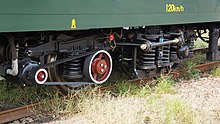Axis generator
The axle generator , in some designs also the axle cover generator, is used to supply power to railway cars for lighting and comparable small consumers. In modern railroad cars, this function is taken over by the train busbar .
functionality
The generator sits on the outside (hence the name as an axle cover generator) or next to the axle of the railroad car and runs with it. So electricity is only generated while driving. The supply when stationary is provided by accumulators that are charged while driving.
In the case of direct current generators, the ability to change the polarity when changing direction must be created in order to charge the battery with the correct polarity . In addition, a device had to be created that kept the voltage as constant as possible at different driving speeds and thus generator speeds. An additional voltage limitation protected the connected electrical devices from damage.
history
The first experiments with electric train lighting were carried out in 1881. However, the batteries and accumulators used could only provide the electrical energy for the lighting for a limited time, which is why a supplementary energy source was soon sought. Either closed train lighting, which was supplied by a central energy source, or individual car lighting could be used. However, since most of the steam locomotives used at the time were not equipped with a powerful electrical power supply and the individual car lighting promised greater flexibility, individual car lighting prevailed in Europe, first in long-distance trains. A combination of axle generator and accumulator was used. Due to the high acquisition and maintenance costs of the individual car lighting, closed train lighting was sometimes used on small and branch lines, whereby the energy supply for the entire train was ensured via an axle generator in the baggage car . This arrangement was chosen, for example, for the local railway company .
Until the 1970s, the axle generator was the standard power supply, especially for passenger coaches that were used in trains with steam or diesel drives. When the international UIC and OSJD railway associations decided that the train heating should only be operated electrically to avoid double equipment, the heating cable became a train busbar. It could also be used with comparatively little effort to supply the other electrical consumers, such as air conditioning systems in passenger coaches. This meant that the axle generators and the associated switching devices could be omitted.
Newer development
In the context of considerations on the digitization of freight wagons and the power supply required for this, consideration is given to using axle generators as a bridge technology before the introduction of the digital automatic coupling . This is supported by their easy retrofitting and sufficient performance. In addition, axle generators offer independence from the equipment of the locomotive and other cars in the train. The relationship between the supply and consumption of electricity is seen as a possible problem, especially with short car tours.
See also
Web links
Individual evidence
- ↑ a b Schützenhofer jun.-Scheichl .: Illumination of the railway carriages . In: Dr. Baron v. Röll (Ed.): Encyclopedia of the Railway System . tape 2 . Berlin, Vienna 1912, p. 152 ff . ( zeno.org ).
- ^ Daniela Wilbring, Manfred Enning: "Power supply on freight wagons - Current efforts towards standardization", ETR , November 2019, page 66.

